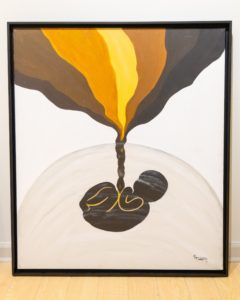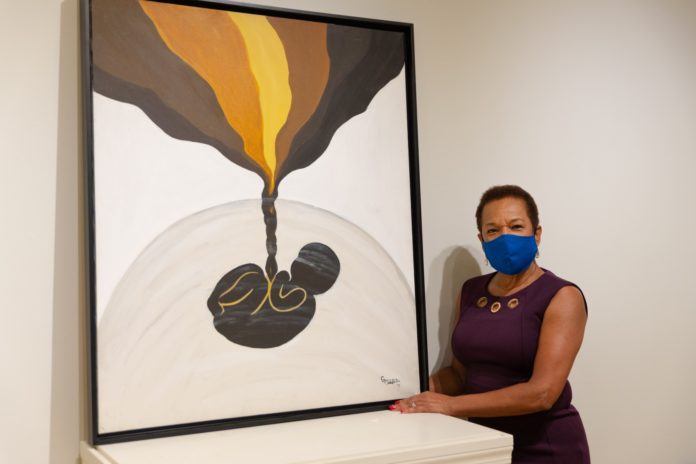A chance meeting at the Atlanta airport between a Mercer University professor and alumna unearthed nearly a half-century of history.
Dr. Sarah Gardner, Distinguished University Professor of History, was waiting for a shuttle back to Macon after a long day of transatlantic travel and delayed flights.
“It was well after midnight. I was exhausted and frustrated,” Dr. Gardner said.
At the same time, Gwendolyn Payton, who graduated from Mercer in 1972, was waiting for a separate shuttle.
“If you know me, you know I’m a talker,” she said with a laugh.
Payton sat next to Dr. Gardner and struck up a conversation. The connection was instantaneous.
“I kept thinking, who smiles at 1 a.m.? And how can anyone be happy at this absurd hour? But then, I smiled, too,” Dr. Gardner recalled. “I couldn’t help it. My mood improved.”
There was a lot to talk about when Payton realized Dr. Gardner worked at Mercer. It struck Payton that she was speaking to a female history professor; she could not recall any in the department when she attended in the late ’60s and early ’70s.
This brought Payton back to her memories as a student pioneer for women’s rights and Black equality — and the setbacks she faced at the time.
Her extraordinary story will be on display at Plunkett Gallery beginning Sept. 21 in a new show, “Faith of The Dreamer: Opposition to the truth may derail the dream but the faith of the dreamer prevails”
Trailblazing times for Mercer and the nation
Payton grew up in Macon, and she felt an instant connection to Mercer’s campus as a part of the Upward Bound program.
“We had experiences we could have never dreamed of,” she said. “That program allowed me to set my sights on being able to go to college.”
Upward Bound propelled Payton to choose Mercer, where she arrived only five years after Sam Oni, Cecil Dewberry and Bennie Stephens became the first Black students to integrate the campus in 1963.
Of course, 1968 was a year that the winds of change swept through the country. Payton became an activist to pave the way for Black students to feel more comfortable on campus in the future. She helped found a Black student union, “so African-Americans, or anyone, could learn about the contributions of African-Americans to this country,” she said.
Payton recalls faculty and administrators Dr. Joseph Hendricks (affectionately known as “Papa Joe”), Professor Tom Trimble and former President Dr. Rufus Harris as allies in the fight for civil rights, working with students to revise racist curriculum and create classes in Black studies and history. The contradictory nature of this time on Mercer’s campus was chronicled in “The Stem of Jesse,” a book by Will D. Campbell.
It wasn’t easy. Payton encountered resistance from many who were not ready for change in tense meetings she described as “battles” in the war for greater equality. The biggest of these ended up being her course of study.
Originally, Payton planned to double major in biology and art to pursue a specific passion, becoming a medical illustrator. A program at the Medical College of Georgia gave her a robust portfolio of work, and Payton cemented her passion while completing all the necessary classes at Mercer for an art major.
Throughout this time, Payton felt she was being dismissed by the then-chair of the Art Department, who is no longer living. She said that “he was not particular” about having Black students or women working in his department. The worst moment, Payton recalled, was when he told her she wasn’t smart enough to get a degree from his department.
“And at the time it just broke my heart,” she said. “Even now, I get kind of emotional for someone to say that to me.”

Despite a previous arrangement to use Payton’s Medical College of Georgia portfolio as her senior project to fulfill the gallery requirement for graduation, the goalposts seemed to shift upon her return to campus in the fall of 1971. At a meeting with the chair, Payton said he would not accept her portfolio in the senior exhibit: “He told me my work was too controversial.”
One of the two controversial pieces in question, titled “Rebirth of Colored Folk,” depicts a Black infant connected by an umbilical cord to several shades of black and brown colors. Despite the cultural connotations of the painting being rejected, Payton pressed the chair to remain in the exhibition, recalling, “I had others that I thought would work other than the two he said were controversial. But he just said, ‘No, no you don’t qualify. You can’t put that in there.’”
At the time, Payton had recently gotten married and was pregnant with her first child, so returning for an additional semester didn’t seem like an option, plus she felt like there was nobody to whom she could appeal the decision.
“There was a lot of turmoil at the time. … There were little skirmishes going on where we were trying to focus on the main battle,” she said. “So with that, I just got my degree in biology. Graduating with a Mercer degree was winning the war.”
And with that, Payton moved on from what felt like an unfinished chapter, while continuing to make art throughout her life.
A wrong reversed at the right time
When Dr. Gardner heard Payton’s story while sitting at the airport, she was struck by her positive energy, and all of the valuable memories and experiences she shared about her time at Mercer despite the challenges of integration.
“If universities can grant honorary degrees, I thought, certainly they can grant a major to a student who completed the required coursework but was prohibited from participating in the senior art show,” said Dr. Gardner.
She promised Payton that she would look into the matter.
She got the attention of Dr. Anita Olson Gustafson, dean of the College of Liberal Arts and Sciences, and they set about verifying Payton’s account with the registrar. Then, after alerting current Art Department faculty Craig Coleman and Ben Dunn about the situation, the faculty came up with a plan.
Although it was 48 years later, Payton would stage her senior show.

Finally able to fulfill the requirements to be granted a major in art, Payton will open “Faith of the Dreamer” at Plunkett Gallery Sept. 21, followed by a reception and artist talk at 10:30 a.m. Sept. 25. The reception will be held outdoors in front of Hardman Hall due to COVID-19 regulations. It also will be live streamed on Facebook through the Plunkett Gallery page.
“To exhibit Gwen’s work now is to acknowledge her accomplishments and the historical failure of the institution simultaneously,” said Ben Dunn, director of the McEachern Art Center and curator of the exhibition. “It’s a course correction and a way for those of us involved in the project to promote justice in our various capacities at the university.”
The paintings in this exhibit represent artwork from Payton’s days at Mercer, as well as periodic commissions and pieces from workshops she has attended in Atlanta; Chattanooga, Tennessee; Asheville, North Carolina; Savannah; South Carolina; and New York. “Rebirth of Colored Folk,” the original painting deemed too controversial to be shown, will be prominently displayed. Some works are available for purchase. To inquire, contact Dunn at dunn_bwr@mercer.edu.
These days, Payton has geared more of her art toward children’s portraiture.
Payton is excited to focus on her art after other priorities took precedence over the years, such as raising her family and working with her husband to run his pediatric medicine practice.
“At this point in my life, this is what I want to do,” she said.
She takes her strength from her mother, whom Payton said always encouraged her artistic talent as a child. Before her mother passed away earlier this year, she learned of the upcoming exhibition.
“I sent a note to Dr. Gardner that I could never express to her the joy my mother felt,” she said. “It was priceless, for her to know about my show.”
Most importantly, she chides those who say it’s too late for this show to matter, or that it’s the wrong time to open it due to the chaotic upheaval taking place nationally in 2020. While noting how unrest over racial tension in the ‘60s and ‘70s feels similar to current events today, Payton said that now, “I see something very different happening. I don’t see people turning a blind eye.”
This synchronicity is what inspired the title of “Faith of The Dreamer: Opposition to the truth may derail the dream but the faith of the dreamer prevails.” In Payton’s words:
“For me, the time is perfect. Not only to help people to see that there’s been things happening all along, but for people to see that there were things that could derail or change their direction, but it can’t stop them from dreaming about who they want to be in life. Right now, with the divisiveness in the United States, we need to understand that for us to be the way we want to present ourselves to the world, we need to understand that while you deal with things as they come, you should never be losing hope that things could be better, that things could work out better than you ever dreamed.”
For faculty at Mercer, the show marks a turning point to heal the wounds of the past with anti-racist action.
“Many decades ago, a chair of a department exercised his power to block a Black student from fulfilling the requirements for a major. Gwen’s exhibit is long overdue,” Dr. Gardner said.
All this from a late-night wait for a ride home. In fact, had Dr. Gardner’s flights arrived on time, the two never would have met. Payton, though, does not believe the fateful coincidence was an accident.
“It wasn’t for me to choose the time,” she said.










